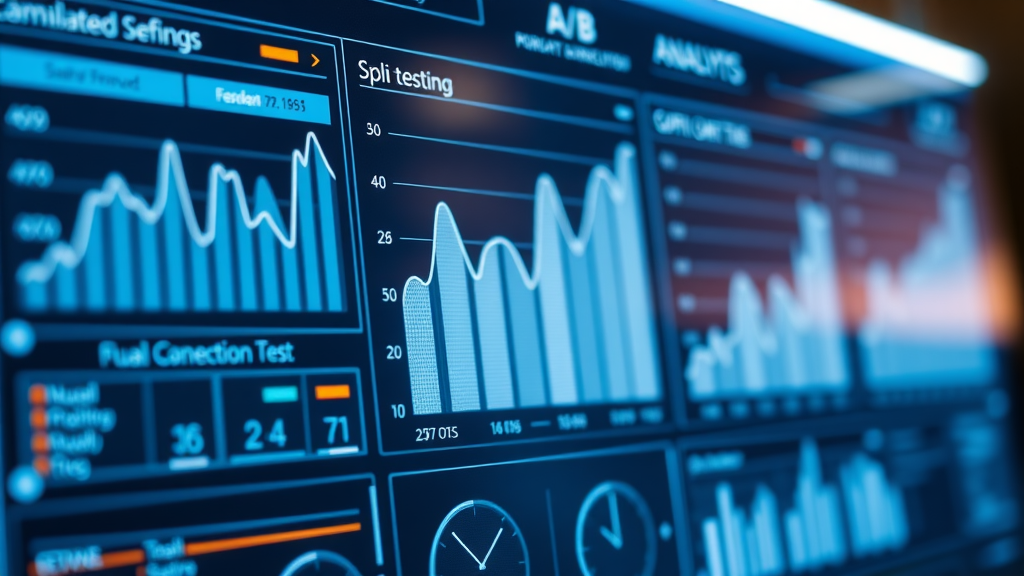Did you know that more than half of all marketing campaigns never hit their targets? If your last marketing campaign didn’t deliver the results you hoped for, you’re not alone—and you’re not out of options. This guide pulls back the curtain on what really causes poor campaign performance and delivers practical, expert-backed fixes you can apply today. Get ready to unlock actionable strategies and transform your next marketing campaign into a measurable success.
Why Campaign Performance Fails: Surprising Stats & Unconventional Truths
"Did you know that over 50% of marketing campaigns never achieve their intended goals? Campaign performance falters most often due to hidden pitfalls companies don’t even realize exist."

When it comes to campaign performance , most businesses focus on the obvious: ad spend, creative assets, or targeting settings. But the real reasons for underperformance are often hidden deep within analytics dashboards or masked by outdated strategies. Take this: even the most data-savvy marketing teams rarely leverage the full power of key metrics and tailored performance reports. Outdated goals, poorly defined target audiences, and a lack of campaign optimization contribute far more to lackluster results than marketers might think.
Many brands also overlook the cumulative impact of weak campaigns. One failed marketing campaign might seem insignificant, but over time, these stumbles add up—wasting budgets, missing KPIs, and eroding brand awareness . To reverse this trend, it’s crucial to recognize these hidden pitfalls and address them before launching your next campaign. Ready to outpace your competition and finally leverage the full value of every ad campaign ? Keep reading.
What You'll Gain from Mastering Campaign Performance
- Immediate steps to boost marketing campaign performance
- How to identify and correct poor campaign optimization
- Key metrics every successful campaign measures
- Actionable tips for every marketing channel
Understanding Campaign Performance: The Foundation of Effective Marketing Campaigns
What is campaign performance and why is it crucial for any marketing campaign?

Campaign performance refers to the ongoing measurement and evaluation of the success of a marketing campaign using a series of predefined key performance indicators (KPIs). This process is essential for organizations aiming to increase their brand awareness , boost conversion rates , and maintain a competitive edge in today's fast-paced digital marketing landscape. When your marketing team actively tracks performance metrics , they gain clear insights into what’s working—a crucial advantage for timely campaign optimization and maximized returns.
Effective marketing campaign performance provides benchmarks for future campaigns, guides resource allocation, and helps set measurable goals. Without these insights, campaigns can run off track, fail to connect with your target audience, and ultimately drain your marketing budgets with little to show for it. As campaigns become increasingly sophisticated, understanding and prioritizing campaign performance enables marketers to respond swiftly to market changes, refine messaging, and surpass campaign goals.
Key performance indicators (KPIs) that define marketing campaign success
To evaluate the success of a marketing campaign , your team must carefully select key performance indicators that are closely matched to your goals. The four fundamental performance indicators include open rate (especially for email campaigns), click-through rate , conversion rate , and return on investment (ROI) . These metrics help to gauge engagement, assess the effectiveness of your messaging, and calculate the true profitability of your efforts.
A high open rate indicates your subject lines and brand reputation capture attention, while a strong conversion rate demonstrates that your content or offer effectively drives desired actions, such as sign-ups or purchases. ROI quantifies whether a campaign’s revenue justifies the cost, and click-through rate reveals campaign message relevance. Regularly tracking these performance indicators ensures your campaigns remain both ambitious and achievable.
| Campaign Type | Open Rate | Click-Through Rate | Conversion Rate | Return on Investment (ROI) |
|---|---|---|---|---|
| Email Marketing | 20-30% | 2-5% | 1-3% | 300-400% |
| Social Media Ad Campaign | N/A | 0.5-1.5% | 1-2% | 150-250% |
| Search Engine Marketing | N/A | 3-6% | 2-4% | 400%+ |
Diagnosing Poor Campaign Performance: Most Common Pitfalls in Marketing Campaigns
Neglecting key metrics and performance indicators in campaign optimization
- Ignoring data analytics
- Unclear campaign goals and targets
- Lack of social media engagement
- Improper A/B testing

Many marketers fall into the trap of neglecting key metrics and not monitoring vital performance indicators . Failing to leverage data analytics , such as insights from Google Analytics or social dashboards, leaves teams blind to what’s actually working. When campaign goals aren’t well-defined, determining the success of marketing efforts becomes guesswork, and performance report accuracy plummets. This frequently results in wasted marketing budgets and underperforming campaigns.
Other common pitfalls include not engaging with audiences on social media platforms, skipping proper A/B testing , or ignoring changes in the search engine landscape. When these essential steps in campaign optimization are overlooked, campaigns rarely reach their full potential. In the era of digital marketing, relying on instincts instead of real-time performance data is a risk few brands can afford.
Real-World Examples: Failure and Success in Marketing Campaign Performance
"A single underperforming marketing campaign can cost a business more than $100,000 in missed opportunities."
Consider a retail brand that launched a major digital ad campaign but never tracked its open or conversion rates. The result was huge spend with little market impact. In contrast, a rival brand implemented robust performance report routines, optimizing creative assets every week. The latter’s marketing campaign not only exceeded its ROI targets but also grew brand awareness and increased the company’s customer base—demonstrating the power of informed campaign optimization.
The lesson? Continual performance measurement—and a willingness to adjust strategies based on concrete performance data —is what separates successful marketing campaigns from wasted opportunities. Companies that make campaign optimization a routine part of operations consistently see better engagement, more conversions, and a sustained competitive advantage.
Key Metrics for Measuring Campaign Performance in Marketing Campaigns
Performance metrics: open rate, conversion rate, ROI, and more

The central performance metrics every marketing team must track include open rate , click-through rate , conversion rate , and return on investment (ROI) . For email and social media marketing campaigns, the open rate reveals whether your messaging grabs attention. Click-through rate offers insight into the relevancy and persuasiveness of your content or offer, while conversion rate is tied directly to your campaign goal—whether that’s purchases, signups, or downloads.
ROI is a financial measure that compares the revenue gained to the amount spent—an essential component in campaign optimization. Regular evaluation of all campaign metrics ensures you’re focusing on what truly impacts the success of your marketing campaign. By using these metrics, marketers can adjust strategies, boost engagement, and ensure budgets deliver maximum impact.
Choosing the best key performance indicators for your marketing campaign
- Open rate (for email and social media marketing campaigns)
- Click-through rate
- Conversion rate (sign-ups, purchases, etc.)
- Return on investment (ROI)
Choosing the right key performance indicators depends on your specific campaign goal and marketing channel. For example, a social media brand awareness campaign will emphasize engagement metrics, while an e-commerce campaign may prioritize conversion rate and ROI. Regularly revisiting KPIs ensures they remain relevant as goals and platforms evolve. Aligning key performance indicators with business objectives drives smarter decisions and more impactful marketing campaigns.
| Metric | Target | Actual | Status | Next Actions |
|---|---|---|---|---|
| Open Rate | 25% | 20% | Below Target | Test subject lines |
| Click-Through Rate | 2.5% | 3% | Above Target | Expand targeting |
| Conversion Rate | 2% | 1.2% | Below Target | Optimize landing page |
| ROI | 300% | 210% | Needs Improvement | Refine ad spend |
The Step-by-Step Process to Campaign Optimization for Better Campaign Performance
Optimizing ad campaigns across digital platforms

A successful ad campaign today spans multiple digital channels, from Google Ads to social platforms and beyond. The first step in campaign optimization is consolidating all performance data —open rates, conversion rates, and click-through rates—from each source into a single performance report . Analyzing these key metrics helps pinpoint which channels outperform others and where marketing budgets should be increased or trimmed.
Next, marketers must continually refine targeting and creative assets, using A/B testing to optimize landing page design, ad copy, and calls to action. Those who set clear goals and review campaign performance at least weekly can quickly adjust campaigns before wasted spend accumulates. This data-driven process ensures high-impact campaigns and sustained competitive growth across every digital marketing channel.
Leveraging social media for superior marketing campaign performance
Social media platforms are goldmines for expanding reach and increasing brand awareness . Effective marketing campaign performance requires more than just posting regularly, though. Marketers who monitor engagement metrics—likes, shares, and comments—can tailor content to resonate with their target audience in real time. Using features like Instagram Stories, Facebook Live, and Twitter polls enables brands to interact more personally, increasing engagement and fostering loyalty.
Integrating automation tools and social listening software allows you to capture valuable audience insights and spot trending topics. These tools help refine campaign messaging and drive higher conversion rates by delivering the right message to the right person at the right time. When social media data is fed back into the overall performance report, your marketing team benefits from a holistic view that amplifies campaign optimization success.
Data-driven adjustments to campaign goals and performance indicators
Continuous improvement is at the heart of campaign optimization. By reviewing and reacting to up-to-the-minute performance data , marketers ensure campaigns remain aligned with shifting goals and market demands. If the data shows a stagnating conversion rate, investigate whether your landing page or ad creative needs a refresh. Campaigns driven by real-world key metrics allow teams to abandon underperforming tactics and double down on what works—maximizing every dollar spent.
With each campaign cycle, set new benchmarks and adjust key performance indicators as your marketing strategy evolves. This feedback loop not only improves the current marketing campaign but also builds institutional knowledge, empowering your team to achieve the success of marketing campaigns long term.
Success Stories: Transforming Poor Campaign Performance into Outstanding Marketing Campaigns

Case Study: From underperforming to top-performing marketing campaign
One noteworthy tech company struggled with low conversion rates and a bloated marketing budget due to scattered campaigns and unclear goals. By introducing regular performance report reviews and setting highly specific KPIs—focused on lead generation and actual signups—they began rigorous A/B testing on email content and landing pages. Within three months, open rates doubled, conversion rates increased by 65%, and the overall ROI soared.
This turnaround was engineered by prioritizing campaign optimization steps, embracing data-backed decisions, and aligning every tactic with a single, clearly defined campaign goal. The marketing team not only achieved, but exceeded, the success of marketing campaign objectives, providing a clear blueprint for others to emulate.
Powerful lessons from campaign performance turnarounds
"Focusing on campaign optimization increased our campaign ROI by 200% within one quarter." – Marketing Director, Successful Brand
What these transformations teach us is simple: the difference between mediocre and outstanding campaign performance comes down to commitment and consistency. Teams who measure, iterate, and don’t shy away from changing tactics are those who repeatedly win. By leveraging performance reports, setting meaningful KPIs, and constantly refining efforts, any business can recover from poor marketing campaigns and deliver sustainable, impressive results.
The true success of marketing doesn’t come from a single good idea—it comes from the relentless pursuit of better data, smarter processes, and continuous learning. Whether you’re running local ads or global campaigns, campaign performance turns on the choices you make after you see the first round of results.
People Also Ask: Insights for Campaign Performance
What is a campaign performance?
Campaign performance is the measurement and evaluation of the effectiveness of marketing campaigns using specific key performance indicators, such as open rate, conversion rate, and ROI, to determine how successfully campaign goals are being met.
How do you measure campaign performance?
Campaign performance is measured by analyzing key metrics—including conversion rate, click-through rate, open rate, and ROI—within performance reports matched to the campaign’s objectives.
What is the formula for campaign performance?
A common formula for campaign performance is: (number of conversions / total campaign interactions) x 100 to get conversion rate, with ROI calculated as (revenue – cost) / cost.
How do you optimize campaign performance?
Optimize campaign performance by regularly reviewing performance metrics, refining targeting, testing different creative strategies, adjusting budgets, and analyzing outcome data to guide ongoing campaign optimization.
Expert Tips: Simple Tricks for Immediate Campaign Performance Gains
- A/B test your messages and creatives
- Segment your audience for tailored marketing campaigns
- Set clear, measurable campaign goals
- Monitor KPIs weekly
- Refine budgets based on real-time performance reports
- Leverage automation and analytics tools

If your campaign performance isn’t where you want it to be, these actionable tricks can yield instant improvements. Start by A/B testing all aspects of your campaigns—from subject lines to landing pages. Even subtle differences can lift open rates and conversions. Always segment your audience, so your messages feel highly relevant and engaging, rather than generic.
Set specific, time-bound campaign goals and measure your progress against them using detailed, up-to-date performance reports . By allocating budgets dynamically, based on what’s truly working, you can maximize impact and minimize waste. Lastly, embracing automated analytics tools reduces manual reporting overhead and surfaces optimization opportunities you might otherwise miss.
Essential FAQs: Improving Your Campaign Performance
- What are the best tools for campaign optimization?
- Which performance indicators matter most for my industry?
- How often should I run performance reports?
- Why is my conversion rate stagnating?
- Can social media truly impact campaign performance?
The choice of campaign optimization tools ranges from Google Analytics and HubSpot to social media management platforms like Hootsuite and analytics suites such as SEMrush. The most valuable performance indicators depend on your industry: for e-commerce, focus on conversion rate and ROI; for SaaS, note sign-ups and customer retention. Performance reports should run weekly for active campaigns, and monthly for ongoing brand campaigns.
If your conversion rate is stagnating, assess your landing pages and creative assets—the culprit often lies there or within the audience targeting. And yes, social media can dramatically affect campaign performance by extending reach, driving engagement, and providing real-time feedback to aid rapid optimization.
Key Takeaways for Sustainable Campaign Performance in Marketing Campaigns

- Regularly analyze and act on performance metrics
- Never neglect campaign optimization steps
- Align every tactic with clearly set campaign goals
- Leverage real-world performance reports for insights
Ready to Boost Your Campaign Performance? Take Action Today
"Your next customer is searching online right now—can they find you? Schedule a free strategy session and let’s make your business the one they connect with. Book your free marketing strategy with our team today. Call: 314-560-4642 or visit: https://marketingconnectionsllc.com/get-in-touch "
To enhance your understanding of campaign performance and optimization, consider exploring the following resources:
-
“10 Key Metrics to Measure PPC Campaign Success” : This article outlines essential metrics such as Cost Per Acquisition (CPA) and Return on Ad Spend (ROAS), providing insights into evaluating and improving your pay-per-click campaigns. ( gartner.com )
-
“A Guide to Measuring and Analyzing Your Campaign Performance” : This guide offers a comprehensive approach to assessing marketing campaigns, including steps like analyzing existing strategies, setting objectives, and identifying relevant KPIs. ( marketingevolution.com )
By delving into these resources, you’ll gain actionable strategies to diagnose and enhance your marketing campaign performance effectively.
 Add Row
Add Row  Add
Add 






Write A Comment